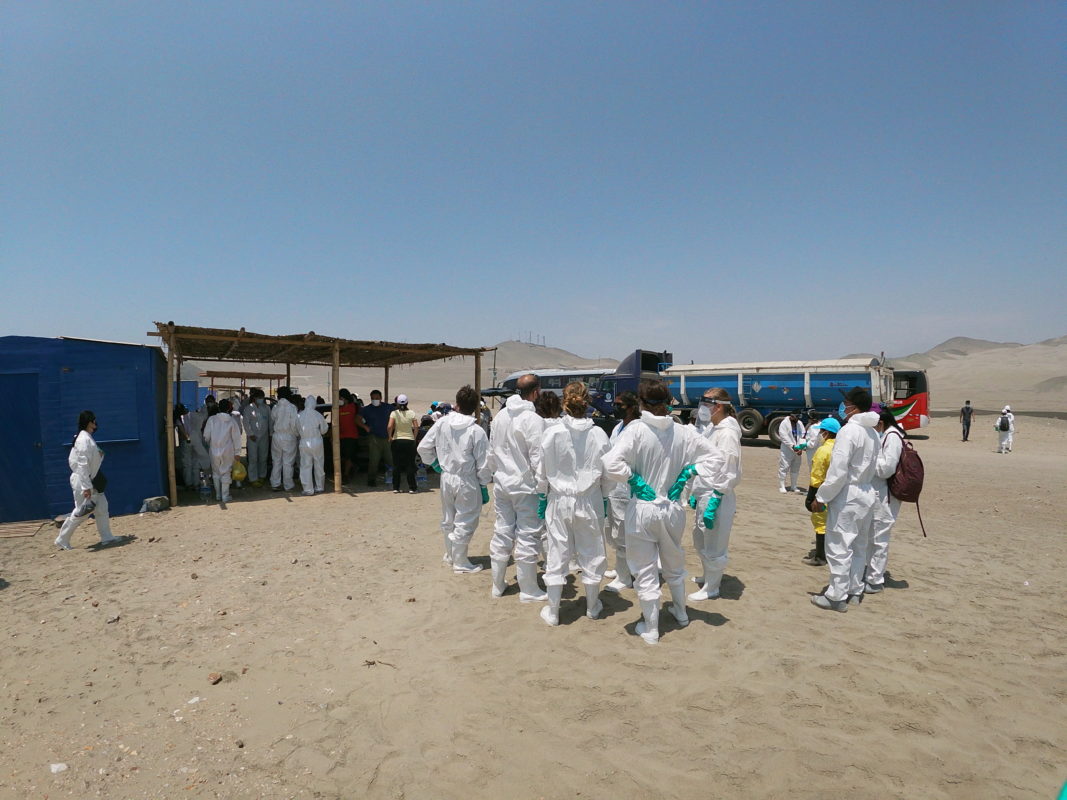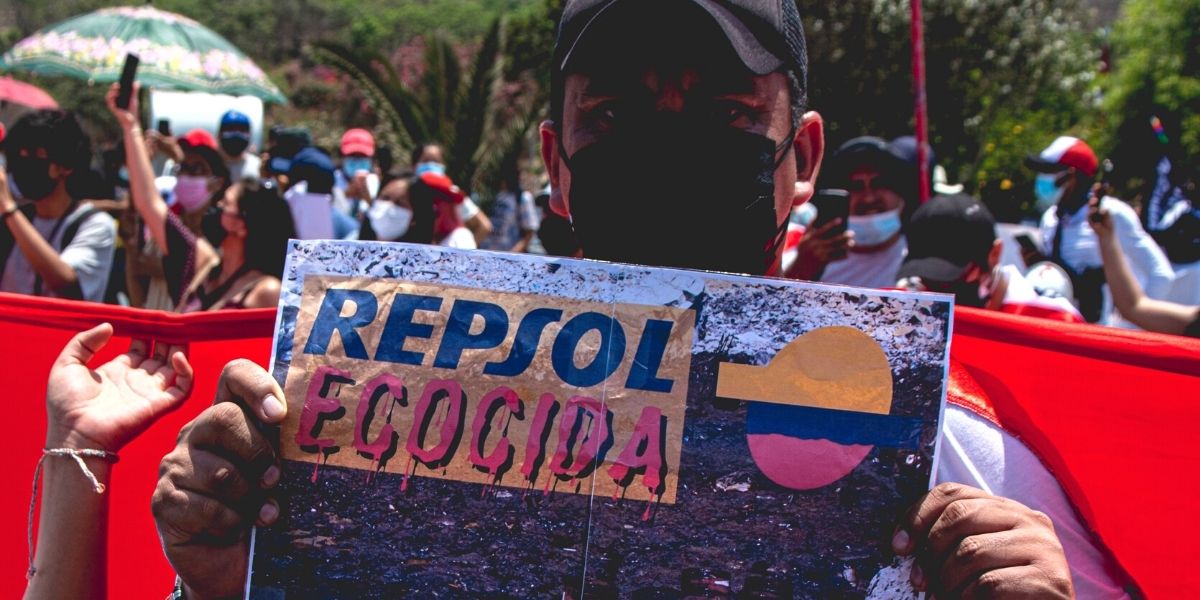Cover photo: FOCSIV
Written by: Francesca Palmi, Linda Marisol Perina, Sara Dell’Amico – FOCSIV volunteers in Peru
“Repsol: ¡hazte cargo!” – “Repsol: take responsibility for what happened!” – is the motto that Peruvians has been chanting since 15 January, the day of the disaster caused by Repsol, the Spanish oil multinational. The company is responsible for the biggest oil spill that ever occurred in the Peruvian capital, Lima, with about 11,900 barrels of crude oil thrown into the sea, according to the Peruvian Environment Ministry. The news shocked the whole country and citizens went to the streets to protest. It is in this context, that Italian volunteers from Focsiv working in Peru decided to support the animal-rescue operations and write this article to inform the international community.
What happened in Ventanilla?
On 15 January 2022, one of the most severe ecological disasters in the history of Peru took place. During the transfer of crude oil from the Italian tanker Mare Doricum, owned by Fratelli D’Amico Armatori S.p.A, to the refinery La Pampilla, owned by the Spanish company Repsol, oil spilt into national waters along the coast of La Ventanilla (Callao region), located 30km north of Lima and famous for its marine biodiversity hosted by two protected reserves. The amount of oil spilt into the waters of the Pacific Ocean reaches 11,900 barrels or 1.65 million litres of crude oil. The dramatic disaster reports extensive damage to the ecosystem, flora, marine fauna and artisanal fishing activity; here is some data1:
- 512 hectares have been contaminated in the Zone of Islets Grupo Pescadores and Punta Salinas of the National Reserve System of Guaneras Islands, Islets and Points, as well as 1,800 hectares in the Ancon Reserved Zone.
- About 300 birds were found dead, as well as many fish species, penguins and sea lions, while more than 1,500 fishermen from coastal communities lost their livelihoods to provide for the needs of their families.
On the night of 25 January, the General Directorate of Captaincies and Coast Guards of the Peruvian Navy (DICAPI, by its Spanish acronym) reported a second oil spill at the Repsol refinery. Another wound for a country in an environmental emergency.
The Peruvian government’s reply
Five days after the disaster, the Peruvian government declared an environmental emergency for 90 days2 to control the oil spill and be able to open an investigation for the alleged crime of environmental pollution. The emergency declaration covers all areas affected by the black spot, an area of 3 km2. On 28 January, the judge in charge ordered four Executives of the La Pampilla refinery, including the Executive Director, to be banned from leaving the country for 18 months as part of the investigation for their alleged responsibility in the crime.
On 31 January, the Environment Ministry decided to limit the refinery’s oil loading and unloading operations until Repsol submits a contingency plan 3 for oil spills at sea, as well as updated certifications from the competent authorities approving the integrity of the oil facilities to the Enforcement Agency for Environmental Assessment (OEFA, by its Spanish acronym). However, in order to guarantee the supply of crude oil in the country, OEFA authorized for ten days the resumption of loading activities of hydrocarbons, specifying that this authorization would not imply the revocation of the administrative order to stop activities and ensuring the monitoring of compliance with the measures established.
Repsol: negligence and omissions
Despite the ecological catastrophe, the oil company tried from the beginning to evade its responsibility for the serious damage caused to the Peruvian biodiversity and environment. As a first reaction to the criminal charges of environmental pollution, the Spanish company shifted the responsibility to the abnormal waves caused by the eruption of the submarine volcano Tonga which had occurred the previous days in Oceania; those waves would have caused the rupture of the connections of the ship to the Italian platform, thus generating the oil spill, according to the company spokesperson.
As days went by, the company’s statements became inconsistent: on one hand, Repsol explained that the contingency plan, approved by the Peruvian government in 2015, had been correctly applied, whereas the Mare Doricum’s Captain publicly stated that the adoption of the necessary countermeasures to contain the emergency had been delayed. On the other hand, the company reported a spill of only 6,000 barrels, while local authorities reported the spill of as many as 11,900 barrels. Lacking teams of skilled workers or sufficient equipment to recover the spilt oil, Repsol had to rely on outside contractors who recruited residents of coastal communities with no resources and no training on how to handle toxic materials.

What is civil society asking for?
Civil society efforts have been huge: associations, volunteers and activists have taken part in several actions to limit as much as possible the damage caused by the disaster; directly-affected local communities and citizens have taken the streets to demand justice and environmental remediation to Repsol. Moreover, it is not the first time that foreign transnational companies have damaged territories through their companies’ activities in Peru: between 2000 and 2019 alone, the oil fields in the Amazon and the North Peruvian pipeline caused 474 spills, leaving serious environmental impacts in addition to more than 2,000 impacted and contaminated sites identified in the northern Amazon4.
The biggest problem remains that the Peruvian State never adopted a clear and decisive position, with appropriate laws and sanctions; on the contrary, foreign companies remain unpunished. Civil society organizations, therefore, denounce the absence of mechanisms to supervise business activity in fulfilling its obligations and due diligence to ensure compliance with the framework of protection of human rights and the environment. They demand not only that Repsol assume direct responsibility for this ecological disaster, but also that it controls and contains the oil contamination with a timely response and with appropriate materials and technological means, respecting the procedures foreseen in the contingency plan. There is an urgent need to strengthen the institutional measures available to deal with environmental emergencies of this kind, especially in terms of the ability to assess, control and sanction environmental crimes, so that companies face their responsibilities. It is time for the State to take on its role as guarantor of rights and enforce respect for the rules, given the countless violations of human rights and the environment that the country faces every day.
Notes:
- Data collected by SERNAP (Servicio Nacional de Áreas Naturales Protegidas por el Estado), an organism accredited by the Ministry of Environment of Peru (MINAM).
- Decreto Supremo 021-2022-MINAM https://busquedas.elperuano.pe/normaslegales/declaran-en- emergencia-ambiental-area-geografica-que-compren-resolucion-ministerial-n-021-2022-minam-2032893-1/
- Resolución MINAM n.° 00013-2022-OEFA/DSEM
- “The shadow of oil: Report of oil spills in the Peruvian Amazon between 2000 and 2019”, Aymara León, Mario Zúñiga, Working Group on Indigenous Peoples of the National Human Rights Coordinator 2020.

